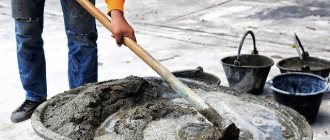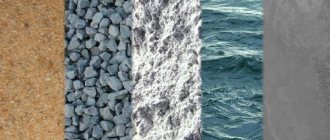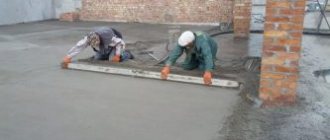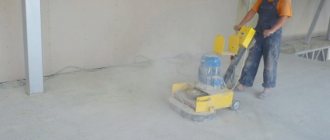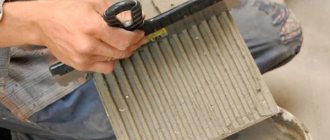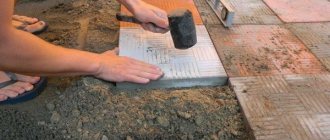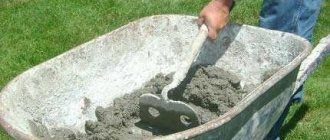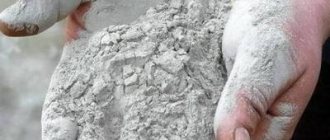It has been common practice to mix cement mortar and PVA glue in the construction industry for quite some time. With this they tried to improve the quality of the cement-sand mortar. The use began almost from the moment PVA glue appeared on the market. The concrete to which it was added acquired higher plasticity and set much faster than an ordinary aqueous solution.
Components of cement mortar.
Nowadays, the trade in building materials offers a considerable number of varieties of dry mixtures, to which glue is added in already balanced quantities. However, their cost is quite high. Meanwhile, if you correctly add PVA glue to a regular cement mortar, in some cases the result can be no worse. Financial costs for consumables will be significantly reduced.
PVA glue and its properties
This substance is a white mass without a distinct odor, having the consistency of medium-fat sour cream. It is based on polyvinyl acetate emulsion, which is one of the types of polymers.
PVA glue can withstand low temperatures and is non-toxic and environmentally friendly.
By purpose, it is divided into stationery, furniture and construction, each of which contains appropriate thickeners and other additives. The latter is packaged for sale in plastic buckets and barrels with a capacity of 1, 2, 5, 10 and 30 kg and can be stored at temperatures from +5 to + 20°C for six months.
It is worth remembering that this substance itself is not waterproof; it is easily diluted with water and is susceptible to high humidity. However, after the hardening cycle is completely completed, its polymerization occurs, it becomes transparent and cannot be dissolved in water. The glued surface can withstand a tensile force of about 1300 g per 1 cm².
At the same time, this glue is able to withstand low temperatures. It retains its properties at temperatures down to -20°C for quite a long time and can freeze and thaw up to 3 times. At the same time, PVA does not have a toxic effect and is completely environmentally friendly.
Types of PVA glue
Household PVA glue is intended for gluing paper products. Outwardly it is a homogeneous mass. Color characteristics - white, sometimes with a cream tint.
PVA office glue is used for gluing paper and cardboard products. Outwardly similar to household PVA glue - also without lumps, white (or slightly yellowish). This type of glue is not frost-resistant.
Universal PVA glue is used for gluing products made of wood, paper, cardboard, leather, and also as a component of putties and water-based concrete mixtures.
PVA glue - composition, technical characteristics, application
In terms of popularity today, this glue is unlikely to rival the once most famous and widespread silicate glue. And the scope of its application seems to have no boundaries. PVA glue is used to glue paper and fabric, wood and glass, leather and metal.
In addition, PVA is included in many paints and primers, putties and dry construction mixtures.
How do different PVA glues differ from each other, does it matter where to use which glue, and what a home craftsman needs to know in order to competently and with the greatest benefit use this truly universal product of the chemical industry.
How PVA stands for, its composition
But, first of all, how is PVA deciphered? PVA is an abbreviation for polyvinyl acetate. We will not draw chemical formulas, they are unlikely to be of much interest to you, but we will say that the composition of PVA glue includes an emulsion of this very polyvinyl acetate in water with various plasticizers and special additives that enhance certain properties of the glue, making it more prepared for applications in a specific area. We will analyze which PVA glues are used and where they are used in this article, and also give some tips on the unconventional use of this miracle composition.
What are the types of PVA adhesives and their use?
Even a fairly experienced home craftsman does not always know which type of PVA glue will give him the best effect in a particular area. Let's try to figure it out together. Classification of PVA adhesives:
1. Household (wallpaper). This is exactly what it was created for; it can withstand 6 cycles of freezing to a temperature of -40°. Of course, it also glues many other things, but we recommend using it for its intended purpose.
2. Stationery (PVA-K). Unlike most of its counterparts, it is not waterproof and frost-resistant. These “weaknesses” must be taken into account, especially when trying to use building mixtures and mortars for additional plasticization. Buy another one.
3. Universal (PVA-MB). It glues everything listed at the beginning of the article; it is this composition that is most often used for the manufacture of concrete mixtures, primers and putties. This glue already allows additional plasticization of any water-based building compositions. Frost-resistant, withstands 6 cycles of freezing to a temperature of -20°.
We recommend: Heat-resistant paint for stoves: heat-resistant paint for stoves and fireplaces, characteristics
4. Super (PVA-M). In addition to everything that a station wagon glues, this glue is also intended for gluing ceramic tiles, felt-based linoleum, etc. Frost-resistant, withstands 6 cycles of freezing down to a temperature of -40°.
5. PVA dispersion is the basis for all adhesive compositions. It is also used in industry not only as an adhesive, but also as a formulation part of multicomponent compositions. There are 2 types:
- unplasticized;
- plasticized.
Additional information about plasticization methods and technical characteristics of PVA dispersions is unlikely to be of interest to the average reader of this article, but many builders prefer to use it to improve the composition of building mixtures. Of course, not in the size of a Euro-cube or barrel, but in smaller packaging, which is available in the assortment of many large hardware stores.
Some manufacturers of PVA-based adhesives slightly expand their classification to attract customers. This is how PVA construction glue appeared, which is positioned as a composition that exceeds the universal one in its properties. Sometimes the names of several types of adhesives are used simultaneously. In such cases, before using the glue, you need to read what materials it is intended for gluing - here the manufacturer will be more careful and will not write that this particular glue can be used to glue ceramic tiles if it is intended for paper.
It remains to add that some types of PVA adhesives are directly manufactured for narrow applications. This does not mean that they cannot glue the same paper or cardboard, they just contain additives for better gluing of specific materials.
PVA and dry construction mixtures
In fact, dry mortars became widely possible because the PVA dispersion was dried and made available in powder form.
Any building mixture consists of:
- filler, which is most often quartz sand, but it can also be chalk, expanded clay, etc.;
- binder, which is cement, lime, gypsum;
- chemical additives, which are often based on PVAD-based dispersion powder.
Of course, in addition to this powder, there are other chemical additives, but their composition and quantity in different mixtures is different. We mention this in general so that a thrifty owner can, in some cases, save money by understanding the essence.
Namely. All chemicals in building mixtures account for from 2 to 5%!, (MISSING) everything else is filler and binder. When buying a cement building mixture, you often buy cement and sand at an expensive price. And drying the PVA dispersion adds a fair amount of cost, so that you end up diluting it with water and getting the same PVA. And for the rest of the chemicals, for most not very special mixtures, some kind of liquid soap or even washing powder in an amount of 2 - 3% of the amount of binder is quite suitable. At worst, even shavings from laundry soap will do.
PVA glue for replacing building compounds
Now that the essence of obtaining fashionable compositions has become clearer, we can detail some of them a little more.
Let's start with the simplest thing.
1. Almost any type of finishing work is preceded by priming the surface. Most manufacturers recommend doing this only with their primer, the deepest penetration possible. But a 10% solution of PVA glue (preferably dispersed) will penetrate just as well and provide excellent adhesion of the material. Try it and see for yourself. And if you add some dye for water-based paints to this composition, you will get an excellent impregnation paint for concrete, which allows you to create wonderful illusions of natural stone and brick. You just need to coat it with varnish.
2. The cheapest finishing putty will be obtained if chalk is mixed with PVA until it becomes thick like sour cream, although for deep cracks you can make it thicker. It is clear that the composition can be adjusted within a wide range by a certain amount of water. There are 2 disadvantages that just need to be taken into account:
- long drying time;
- difficulties in machine processing of the finished surface due to high temperatures in the processing area due to the friction of the working tool.
3. Gypsum putty, like an analogue of plasterboard glue, is obtained by mixing 1 part gypsum, 2 parts chalk and the same PVA glue. But with a little experimentation with the ratios, you can get the perfect product, tailored to your style and work rhythm. The same gypsum or cement mixed with PVA will become an excellent putty for a concrete floor; sometimes it will be useful to add fine sand to this composition. And, no matter what ratio you prepare the cement-sand mixture, depending on the brand and quality of the cement, the fraction and quality of the sand, if you add a glass of dispersed or even universal PVA to the bucket and detergent, as described above, you will be successful replace most of the trendy formulas.
4. Most people consider PVA glue to be the best for gluing wood. And although modern polyurethane adhesives have begun to push PVA out of this area in some places, their relative high cost cannot do this everywhere.
And there is nothing to say about home use - here PVA will not have competitors for a long time.
But wood is a fairly soft material that often suffers serious damage even with minor carelessness in handling. And here PVA can become an indispensable assistant. If you mix it with wood dust, which can be freely found in any wood production, then we get a putty called “liquid wood”. By varying its consistency, you can obtain a composition that can cope with the deepest wounds on wooden surfaces, as well as products made of fibreboard, chipboard and MDF.
5. It remains to add that, given the presence of PVA in the form of a redispersible powder in many building compositions (which can be read on the packaging), we can successfully increase the degree of plasticization of these same compositions by introducing an additional amount of PVA into the finished mixture.
So, when applying a bark beetle mixture using a Hopper plaster gun for exterior finishing of buildings, we recommend adding dispersed PVA at the rate of 1 liter per 25 kg of mixture. This will make the solution more plastic and subsequently even more resistant to external influences.
At the same time, you can safely add dye there; PVA will help them combine into a magnificent mixture.
In general, this glue allows you to achieve interesting results in the preparation of various, including decorative, finishing materials. With its help, select interesting compositions yourself and perhaps you will even want to share them with subscribers of our site, for which both we and they will be grateful to you.
Source: stroi-specialist.ru
2
Types of glue - what to use for household and industrial purposes?
We recommend: Which putty should I choose for walls under wallpaper?
PVA glue has found its application in various fields of activity. Laying tiles, gluing wallpaper, gluing plastic, cardboard, paper, plywood, use as an additive in the glass industry. To get the maximum result when fixing certain materials, we will analyze in more detail the varieties of this universal fixer.
Let's start with the simplest thing - PVA stationery glue. This glue is well known to schoolchildren, students and their parents, because it is used for gluing standard things that are used in everyday life: cardboard, paper, photographs. Stationery glue is absolutely safe; if it comes into contact with the skin, it does not cause allergic reactions, so even children can work with it. Among the disadvantages of PVA stationery glue, one can highlight its low resistance to moisture and negative temperatures.
PVA is used everywhere, hence the wide selection of brands and types
For industrial purposes and repair work, PVA construction adhesive is used. The list of main materials that this composition can fix to each other includes: paper, vinyl and fiberglass surfaces. The technical characteristics of construction adhesive allow it to be used as an additive that increases the adhesion of building mixtures (putty, plaster, primer).
Separately, there are specialized construction fixatives, for example, PVA wood glue. It is widely used by carpenters for working with wood and has increased moisture resistance.
PVA-M super glue is designed for working with vapor-permeable materials. Thanks to this composition, the adhesive seam is as strong as possible, and its application does not require compliance with certain rules. Craftsmen use this glue to work with ceramic tiles, fixing joints in flooring, leather goods, porcelain, fiberboard (chipboard), plywood, glass and wood. PVA-M super glue has increased frost resistance -40°C.
To quickly fix laminate and parquet slabs together, we recommend using Moment PVA glue. It is enough to press the fixed parts of the material together, and the glue instantly sets.
PVA dispersion is an additive to mortars that are used in the printing, footwear, textile and glass industries, as well as in the production of packaging, household chemicals and paints and varnishes. The reason for adding dispersion is to increase the adhesion and strength of the product. PVA glue is also used as a basis for the production of wallpaper glue, which fixes paper-based finishing material to different surfaces (concrete, plaster, wood, cement).
PVA glue based on dispersion
And if you are at a loss as to which composition is suitable for your material, then it is better to stop at universal PVA glue. It has a wide spectrum of action, which allows:
- glue the fabric to a wooden, metal, glass surface;
- use as an additive for putty, primers and water-based cement mixtures;
- fix the floor covering (carpet, linoleum, tile);
- glue synthetic materials onto a paper base, cork, vinyl;
- fasten sheets of chipboard, fiberboard, MDF, decorative plastic.
Features of application
- increases plasticity;
- reduces the hardness of the finished product by increasing bending strength;
- increases the adhesion of concrete mortar to the surface.
PVA office glue is not suitable for use in concrete mix.
This is achieved by maintaining clear proportions of mixing concrete and PVA. In this case, the amount of water should not exceed 5%. Not every type of adhesive can be used. Stationery PVA contains a lot of starch, and wood glue contains unnecessary chemical fillers that worsen the properties of the cement mixture.
Depending on the purpose of the mixture being prepared, the proportions of cement to polyvinyl acetate are determined. For example, screed and masonry require different properties of the mortar.
An important criterion for choosing the type of adhesive for cement is the final humidity in which the finished structure will be used. Despite polymerization, when it hardens and acquires moisture resistance, it is better not to add glue to concrete mixtures for finishing bathtubs, showers, etc.
As a precaution, it is better to use the adhesive-cement composition for landscaping areas where the operating temperature will be above 7°C.
Even children who glue sheets of paper with it in kindergarten or school know about the existence of PVA glue. However, the scope of application of polyvinyl acetate is much wider: it simply cannot be replaced in carpentry work and even in the construction process. In the right concentration, PVA turns into a universal adhesive and sealant with high waterproof ratings.
PVA glue in construction: cement mortar
PVA is often added to the cement mortar. Of course, a lot here depends on the quality of the adhesive composition itself, so preference should be given to products from trusted companies. With the introduction of PVA, the cement mortar acquires additional waterproofing and greater adhesion. Craftsmen recommend applying polyvinyl acetate to the surface before applying the cement mixture, thereby further improving adhesion.
The generally accepted ingredients for creating high-quality cement mortar are sand, cement itself and a mixture consisting of PVA and water in a 2:1 ratio. In this case, it is not necessary to pour water into the glue, but, on the contrary, add PVA to the liquid and mix thoroughly. After drying, polyvinyl acetate becomes transparent, therefore, it will not be noticeable at all.
PVA glue in construction: carpentry and finishing
Quite often, wood is impregnated with PVA glue in order to give it additional water resistance. Additionally, polyvinyl acetate can be used to fix ceramic tiles to wood surfaces. To do this, it is necessary to apply at least 3 layers of undiluted PVA glue, and each layer should be allowed to dry completely.
Polyvinyl acetate is used to treat particularly absorbent surfaces before applying finishing materials, which are characterized by a short drying time. For example, during plastering work, because the plaster can be absorbed very quickly, not giving time to obtain a smooth surface. The use of PVA makes the process of moisture absorption not so fast, allowing craftsmen to work longer with the plaster composition.
PVA glue in construction: plasters, primers, paints
Polyvinyl acetate is used as a plasticizer in plaster mortars. It makes the plaster more durable and improves adhesion to the base. Each master has his own proportions, however, due to the advent of more modern plasticizers, PVA glue is losing popularity in this area of application. Polyvinyl acetate cannot be added to solutions that will be used in rooms with high humidity.
An accessible primer composition can be made from PVA glue; for this, polyvinyl acetate is diluted with water in a ratio of 1:2. After thorough mixing, you should get a white mass with a liquid consistency that is easily distributed over the base. PVA-based paints are used to coat wall and ceiling surfaces. Such water-dispersed compositions are economical and easy to use. However, they can only be used in rooms with normal humidity levels.
Polyvinyl acetate is an adhesive emulsion previously diluted in water. PVA glue is used in the construction industry as an additive to cement mixtures to improve technical characteristics. Often such compositions are used in plastering and leveling work; they also have excellent adhesion to any surface.
Change of material when adding glue
The proportions and technology of addition are determined depending on the purpose of the application, but basically the glue is added already diluted with water. These types of solutions should not be used in rooms with high humidity, since the glue is capable of absorbing moisture, as a result of which the layer may collapse or crack.
Polyvinyl acetate emulsion is one of the types of polymers and is used as a plasticizer. It has virtually no pronounced odor or toxic substances, so that when moisture dries and evaporates, no dangerous compounds are released. As a rule, PVA is added no more than 10% of the total amount of the cement mixture; it provides the following positive qualities:
- Increased plasticity and viscosity.
- Increases bending strength characteristics after complete hardening.
- The design is capable of withstanding a tensile load of at least 1.3 kg/cm².
- Increases the adhesive properties of cement-based compositions, this depends on their purpose. To obtain high-quality tile adhesive, the amount can be 15-20% of the total volume.
- Simplifies the work and application of the solution to the base.
Polyvinyl acetate homopolymer emulsion cannot be used for finishing wet rooms exposed to hot steam. In this case, hydrolysis is accelerated, which promotes constant conversion to alcohol even in concrete. Thus, when plastering walls in bathrooms, baths, saunas, swimming pools, as well as areas exposed to a humid environment, PVA is not used.
Another disadvantage is the lack of control over the strength gain of the mixture, that is, during the process of application and drying there are no exact instructions on the hardening time. This is due to the fact that the setting of the polymer material occurs regardless of the hydration of the concrete.
Glue is added to the DSP only of a certain brand. Types such as wallpaper or stationery are not suitable due to their high starch content, and adhesive bases for wood have many unnecessary compounds and impurities that are not compatible with cement.
To make mortar, it is best to use an aqueous dispersion containing more than 55% polymer additives. It is produced in plastic containers weighing 1-30 kg with a shelf life of up to 6 months.
Proportions and cooking technology
Adding glue is done in two ways. In the first case, PVA is poured in diluted form: the emulsion is poured into a vessel with water and completely stirred until a transparent consistency is obtained. In the second option, it is used in an undiluted, concentrated state.
The ratio of CSP ingredients should be selected based on its purpose:
- If the glue is used in a diluted state, then the optimal amount is considered to be no more than 10%. That is, for 25 kg of cement, take 0.5 liters of PVA.
- To fill a concrete floor: 1 part binder, 2 sand, 3 small crushed stone, 0.2 glue and 0.05 alkali-resistant pigment. Water is poured in for proper mobility.
- When laying tiles, the emulsion should make up about 20% of the total volume. The proportions of cement and sand are 1:5, and the binder should be chosen as M400 or more. There may be little or no water at all. When tiling concrete or aerated concrete slabs, adding glue to the solution will eliminate the need to prepare notches.
- The proportions for restoring screeds are 1: 3: 0.5 cement, sand and emulsion, respectively. 4% epoxy resin is also poured in. Then the mixture will have excellent adhesion to old concrete.
- For plastering work, a cement solution and PVA glue are used in a ratio of 1:0.07. In this case, the composition should already be ready for use. It is recommended to add sand clean and sifted from debris in an optimal amount of 1:3.
PVA glue is an aqueous emulsion of vinyl acetate polymer with special additives that improve the ductility and elasticity of the composition.
In addition to its direct purpose - gluing paper, wood, leather, etc., PVA glue is used as an improver for putties and mortars.
Concrete and cement-sand mortar, to which polyvinyl acetate dispersion is added, acquires better ductility, and the composition sets faster.
Using PVA as a plasticizer additive
- an effective technique that allows you to solve various problems. Thus, by mixing cement with PVA glue, the floor screed better fills all voids, adheres more firmly to the concrete base, and cracks do not form on the surface of the finished screed.
By adding the dispersion to a regular cement-sand mortar, you can get a good tile adhesive. As part of the base plaster, PVA prevents the formation of cracks, improves adhesion to the brick wall, and prevents the surface from crumbling. Sometimes an aqueous emulsion of vinyl acetate polymer is used as a masonry mortar improver.
Profession "Master of finishing construction works"
PM.04 “Performing facing work with tiles and slabs”
Topic 8
Preparation of solutions and dry mixtures of various brands for fixing tiles
Method for preparing tile mortar
The method involves making a cement-adhesive mortar manually (by hand). Professional construction teams today practically do not use this method, due to the length of the mixing process and the instability of the composition. However, in private construction it has not yet lost its relevance.
Advantages of the manual method of mixing tile mortar:
- you can do it yourself;
- solution components are available and cheap;
- the solution is environmentally friendly;
- allows you to level the base for installation;
- proven clutch reliability;
- versatility of application. The solution is suitable for any tile and any surface;
- low cost.
The disadvantage is that the proportions are determined “by eye”, so even within different batches the consistency of the solution may differ. In addition, quite a lot of time is spent preparing the solution, and the constituent elements of the mixture require storage space.
Making cement mortar for tiles with your own hands
Despite the long-standing popularity of the mortar, many users are interested in how to make cement mortar for tiles. After all, the service life of the lined surface depends on this.
Composition of cement mortar
Cement
Only fresh cement is used to mix the mortar. Preferably Portland brand or white cement. It is not recommended to use cement grades below 300 for tiling work. Cement, depending on warehouse storage conditions, loses up to 40% of its properties within a year. Master tilers claim that floor tiles will stick to such a solution, but those laid on the wall will “crawl.” This disadvantage is eliminated by adding more cement to the solution, which leads to an increase in the cost of work.
How to determine the quality of cement
You can check the quality of cement by eye. To do this, squeeze a handful of cement in your palm. If it slips through your fingers, it means it’s fresh; if a lump forms, the cement is not suitable for mortar. This method of determination can be useful when there is an opened bag of cement or it is sold in bulk.
Sand
It is better to use river sand to mix the tile mortar. Before adding to the solution, it must be sifted or washed and dried. Additional impurities (shells, small stones, lumps of clay) contained in the sand will create some difficulties during cladding. Especially if you apply a thin layer of the mixture, which will cause the tiles to lift, and trying to set them in place by tapping them can cause the ceramic to crack.
Advice. Dry sand is easier to sift
Water
There are no requirements for water temperature.
In what proportions should cement and sand be mixed?
The specified components are mixed in a certain ratio (proportions). Moreover, when the brand of cement changes, the ratio changes upward in the composition of the cement:
| Cement brand | Proportions of mortar for tiles in cement mortar (cement: sand) |
| M 300 | 1 : 4 |
| M 400 | 1 : 5 |
| M 500 | 1 : 6 |
Note. The heavier the tile, the more cement needs to be added to the solution.
Adding PVA to cement mortar
You can give the cement-sand mortar additional elastic properties by adding PVA glue to it - 200 g. for 10 l. ready-made cement mortar. PVA will give the mixture greater adhesion to the surface. Moreover, the cost of this modifier is only 80 rubles. for 0.9 kg.
An alternative to PVA at home can be improvised materials (detergent, powder, liquid soap). Some consumers recommend adding laundry detergent or soap to the cement mortar. Why is this being done? To improve the properties of the solution. Such a plasticizer can make the cement mortar for tiles more plastic, which is important when laying floor tiles.
Adding lime to the cement mortar will increase the ability to resist the absorption of moisture (dampness) and add elasticity to the mortar. Slaked lime or its substitute MTS (LP) is used (80 rubles/1l.).
Resistance to low temperatures will be provided by a plasticizer - anti-frost hardening accelerator Primer EC-30 (about 100 rubles)
Cement with PVA - how much to add to the solution?
The method in which PVA is added to the cement mortar has been known since Soviet times. It improves not only technical but also operational characteristics.
Properties of PVA glue
This solution is obtained:
- more homogeneous;
- plastic;
- increases the adhesion force between solution particles;
- improves strength;
- wear resistance increases;
- prevents the formation of cracks, etc.
PVA glue is a polymer and consists of a polyvinyl acetate emulsion. It dissolves well in water, but after drying it is resistant to moisture. It is non-toxic, safe for health and can retain its properties at very high and low temperatures.
Features of application
Before determining the proportions of adding PVA to cement, it is necessary to note which type of this glue is not suitable for construction purposes. This is primarily PVA intended for paper and cardboard products. It contains too much starch and other fillers. Also, you should not take PVA for wood, as it also contains various unnecessary additives.
The second important point is the purpose of the solution. Because the proportions of cement with PVA will be different. For a screed, certain properties are needed, and for laying ceramic tiles, others are needed. And the last nuance is what humidity will be in the room. Despite the fact that after the glue hardens, it polymerizes and is not afraid of moisture, however, it is still not recommended to use it in wet rooms (bathtub, shower room, swimming pool).
Another feature is the temperature regime. Although the glue can withstand high and low temperatures, in order not to risk the final result of reliability and durability, it is better that the temperature be higher than +7 ° C.
Terms of use
The addition of PVA is used as a plasticizer, but in addition it improves the properties of the cement-sand mortar. The proportions of PVA in relation to cement range from 5% to 20%. It all depends on the specific use of this solution. If it is a screed, then 5%-10% of the glue content is quite enough, and if it is for tiles, then it is better not to skimp on PVA and add 20%.
To make it clearer, for 2-3 buckets of cement mortar for screed you need about 0.5 liters of PVA. Add PVA diluted with water so that it mixes more evenly with the entire mixture.
If glue is mixed with cement, without first dissolving in water, the result is a composition that will have excellent adhesion and plasticity properties.
In terms of popularity today, this glue is unlikely to rival the once most famous and widespread silicate glue. And the scope of its application seems to have no boundaries. PVA glue is used to glue paper and fabric, wood and glass, leather and metal.
In addition, PVA is included in many paints and primers, putties and dry construction mixtures.
How do different PVA glues differ from each other, does it matter where to use which glue, and what a home craftsman needs to know in order to competently and with the greatest benefit use this truly universal product of the chemical industry.
